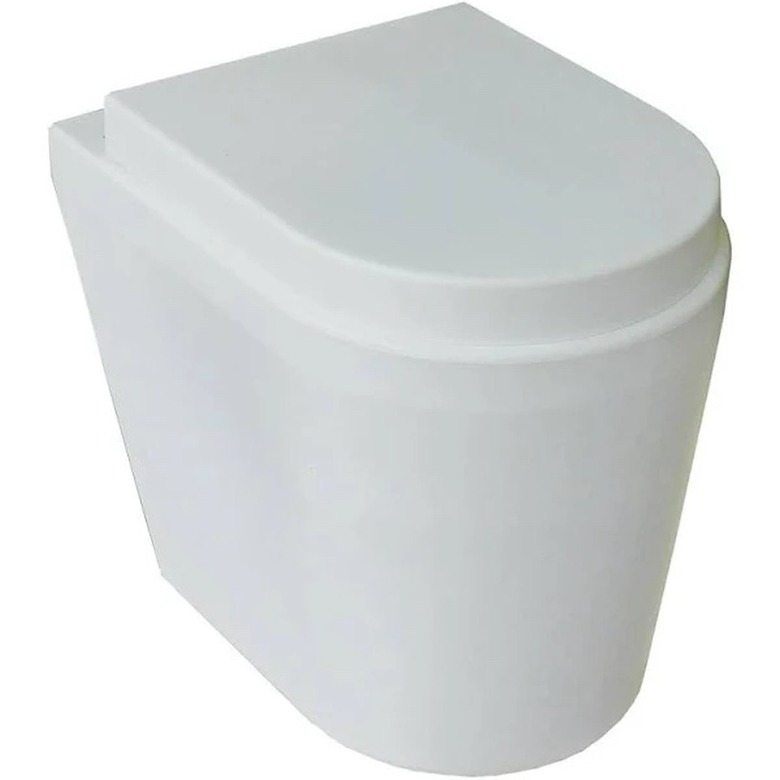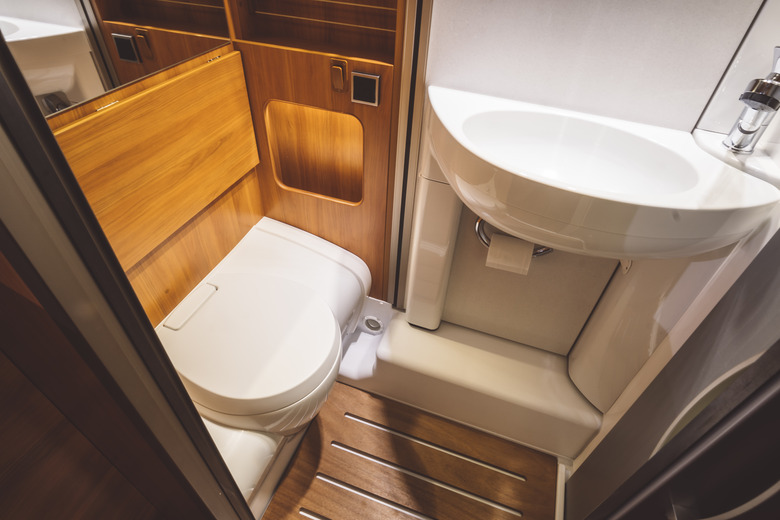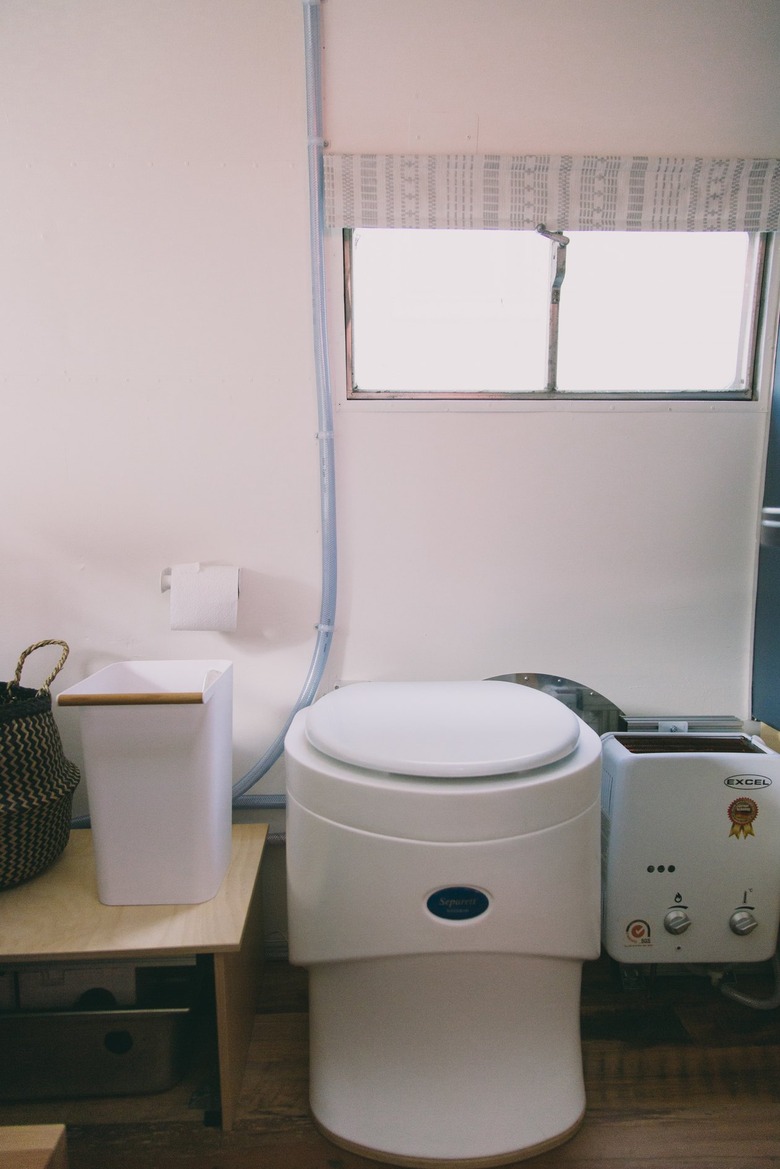How Does A Composting Toilet Work?
Discussions about what makes a composting toilet work may make you queasy, but it's good to get over that because a composting toilet has a lot to offer, especially if you're looking for a sanitary solution for your off-grid home, your RV or your boat. The composting toilet has been around since the 1880s, which is roughly the same time that the flush toilet came into widespread use, and both types of toilet are a response to ages-old sanitation problems that have been responsible for such catastrophes as the Black Death and London's Great Stink of 1858. While a flush toilet is the preferred option for most modern homes, it isn't always possible to have one, so it's good to know that a composting toilet is a viable and perhaps even better alternative.
The most important advantage of a composting toilet over a flush toilet is that it's a toilet system that processes human waste safely while using little or no water. Instead of the pathogen-rich raw sewage a toilet produces, which has to be buried, stored in a septic system or directed to a waste treatment plant, a composting toilet reduces waste to a nutrient-rich, pathogen-free mixture that can enrich the soil and feed nonedible plants. To achieve this ideal, a composting toilet must be built in a specific way, and it must have regular maintenance, or things can go unpleasantly wrong.
Tip
A composting toilet uses little or no water and isn't connected to a sewage system. It holds waste in a composting chamber to which the user adds organic material, and when the waste decomposes sufficiently, it passes into another chamber for removal. Liquids generally flow into a third compartment from where they evaporate or are manually removed.
How Does a Composting Toilet Work?
How Does a Composting Toilet Work?
To be effective, a composting toilet must have more than one compartment to allow water to drain and evaporate from the composting mixture. The composting process can't occur in a single-compartment composting toilet — also known as a 5-gallon bucket — because when the mixture retains more than 60 percent moisture content, anaerobic bacteria thrive, and you're basically left with raw sewage. Most composting toilets on the market have at least three compartments: one for the composting solid waste, one for waste liquids and a collection tray for retrieving the composted waste.
When you use a composting toilet, the solid waste goes into the composting chamber, which must be regularly replenished with organic starter material, such as sphagnum peat moss, coconut fibers or sawdust, to keep it aerated and to hasten decomposition. After each use, you rotate a mixing paddle or drum to homogenize the mixture and expel excess liquid into a chamber below, where it evaporates or is manually emptied. When the compost is ready to extract, you rotate the drum in the opposite direction to deposit the compost into a collection pan, or you sift the mixture into the pan with a built-in rake.
Inside the composting chamber, microorganisms decompose the solid waste, and in the process, they generate some heat, but composting proceeds more quickly with external heat, so many composting toilets come with an electric heating element. As can be expected, the composting chamber isn't odor-free, so most units also have a ventilation fan that must be vented outside the bathroom. Venting also helps circulate oxygen through the mixture to improve aeration and hasten decomposition.
Features You Find on a Good Composting Toilet
Features You Find on a Good Composting Toilet
Sun-Mar products frequently appear on the top 10 lists of compost toilet reviewers because they are easy to maintain and are solid and compact. The Sun-Mar Excel is a self-contained, nonelectric model, which means it doesn't have a heater, so it works in places where neither water nor electricity are available, while the Sun-Mar Compact is one of the smallest composting toilets available. Both feature retractable handles for agitating the mixture, and the handles are accessible from the front instead of the side, so they fit more easily into small spaces.
The Nature's Head toilet, another self-contained unit that tops most reviewers' lists, does have a side handle for rotating the drum, but this handle is designed to occupy as little space as possible, and you can mount it on either side of the unit. What makes this toilet so popular is its ergonomic design, including a comfortable toilet seat, and the ease with which you can maintain it. The containers for liquids and solids are easy to unhook from the main unit, and they have handles, so they are easy to carry. It's a completely dry toilet, so it needs no water supply, and it comes with a ventilation fan and a vent hose.
Some other toilets have features that set them apart. For example, the Separett Villa 9210 DC/AC has a ventilation fan that works on DC power, making it suitable for off-grid situations where wind turbines or solar panels are the primary sources of electricity. It features a pressure-sensitive seat that automatically opens the compost chamber, so you don't have to remember to do that, and also features automatic mixing, so you don't have to remember to do that either. If you're looking for a composting toilet for your standard bathroom that doesn't look like a composting toilet, you want a central composting toilet system, such as the Sun-Mar Centrex, which features a full-size ceramic bowl and a foot pedal that flushes the unit — using one pint of water — into the composting unit located underneath the floor.
Problems With Composting Toilets
Problems With Composting Toilets
If composting toilets were problem-free, everyone would have one, and flush toilets might be more a novelty than the norm. The most obvious problem is that the composting chamber can malfunction for one of a number of reasons, and that leaves you with an unpleasant cleaning job. Malfunctions aren't always the fault of the toilet. They can result from improper use, such as putting in waste other than what results from natural processes and toilet paper.
Many composting toilets suffer from a fundamental design flaw, which is an inability to completely separate solid and liquid waste. The urea in urine degrades into ammonia, and that can actually inhibit decomposition if left in the mix. Toilet manufacturers have created different design solutions, including strategically placed channels that require men to sit while urinating and conveyor belts that automatically separate solids from liquids when you press the flush pedal.
Maintenance Makes a Composting Toilet Work
Maintenance Makes a Composting Toilet Work
The fact is that composting toilets require more maintenance than flush toilets, and performing it isn't always an uplifting experience. Inside Science reports that one engineer in Mt. Shasta, California opens the lid of his toilet every day while wearing a respirator to guard against the strong ammonia fumes and stirs the mixture manually. He considers it a hobby, but ideally, you should just have to turn the handle to rotate the compost chamber and periodically empty finished compost and liquid waste. You should also clean the seat after every use with disinfectant wipes, but be careful not to get cleaning liquids in the bowl, where they can inhibit decomposition of the waste.
Maintenance also involves proper use of the toilet, and that may take some training for people who are not used to waterless toilet systems. Apart from the fact that some composting toilets are designed in such a way that men must sit to urinate, it's important to remember to drop in some compostable starter material, such as peat or sawdust, to absorb some of the liquids and keep the composting mixture viable. With some toilets, you add the starter only after emptying the composting chamber; with others, you apply it as a cover material after each use. Most units can handle toilet paper, but overdoing it can fill the compost chamber too quickly, so a bucket for paper should be handy in the bathroom.
The consequences of poor maintenance can be dire. If the unit has too much water or an insufficient amount of organic compost starter in the compost chamber or if the heat and ventilation are insufficient, the mixture will never reach the grainy consistency it needs to sift into the collection tray. Eventually, the compost chamber will fill, and you'll have to empty it manually, which is a job you definitely don't want to do unless, of course, it's your hobby.
References
- Green Building Alliance: Composting Toilets
- Inside Science: Inside the Controversial World of Composting Toilets
- Tiny House, Huge Ideas: 5 Best Composting Toilets 2020
- A Layman's Guide to Clean Water: Composting Toilet Operation and Maintenance is Easy to Accomplish and Requires No Special Skills or Tools
- Sunrise Specialty: How Does A Composting Toilet Work?
- LetsGoGreen.com: How Do Composting Toilets Work?


